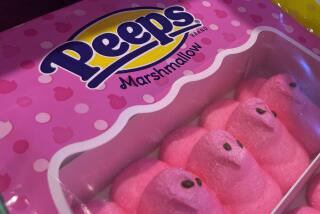Cochineal and Starbucks: Actually, this dye is everywhere

- Share via
Starbucks has declared that it will no longer use cochineal extract, an insect-derived red coloring, in its wares. If anyone is imagining that the use of this dye is rare or new, they’re mistaken.
At a UCLA “economic botany” website we learn, among other things, that cochineal bug, or Dactylopius coccus, if you want to address it formally, is an insect that sucks the sap of prickly pear cactus and was used by the early Mixtec Indians of pre-Hispanic Mexico as a red dye for clothing. The insects were carefully farmed by these peoples. They even domesticated it.
The Spaniards loved the red dye that built up in the bodies of these bugs and shipped cochineal-dyed clothes to Europe. Centuries later, the dye supplanted another dye produced by yet another sap-sucking insect that fed on oak trees because the color was brighter.
For textiles, synthetic dyes took over, but the use of cochineal dye moved on to food. In the U.S. in the 1900s, the article notes, cochineal “began to appear in commercial products of the United States primarily as a food dye, as in pork sausage, pies, dried fish and shrimp, candies, pills, jams, lipstick and rouge, and the brightly colored maraschino cherries.”
Synthetic reds were ultimately used instead for food as well, notably, “red dye numbers 2 and 40, which are believed now to be carcinogenic.”
Adds the Wikipedia entry on cochineal: “Health fears over artificial food additives, however, have renewed the popularity of cochineal dyes.” Today, cochineal extract and carmine (the purer form of the dye) are used in a wide array of foods and cosmetics. Here, for example, is a listing from the website for a flavor-coloring company Wild Flavors Inc:
“meat, sausages, and red marinades…. fruit preparations, jams, gelatin desserts, juice beverages, non-carbonated soft-drinks, baked goods, confections, icings, toppings and dairy products.”
The Food and Drug Administration requires companies to note cochineal extract or carmine among their ingredients because they can cause allergies in some. And, of course, some people have dietary reasons to want to avoid the dye.
The Center for Science in the Public Interest says that cochineal should be removed from foods because of the allergic-reaction issue, but it also states that food dyes in general are problematic because they are deceptive, implying ingredients that a product may not contain (such as real carrots in carrot cake that actually contains no carrots. Starbucks plans to replace its cochineal dye with a tomato-based one (lycopene) in some products. That would not seem to solve the Center for Science in the Public Interest’s objection.
Want to learn more about cochineal? This video tells the story of the bug dye in art. And here’s a video hosted by museum educator Bob Alderink, of the North Carolina Museum of Natural Sciences, about the science of cochineal.
Hungry for more? Check out the book “A Perfect Red,” which traces the history of cochineal.
More to Read
Eat your way across L.A.
Get our weekly Tasting Notes newsletter for reviews, news and more.
You may occasionally receive promotional content from the Los Angeles Times.







